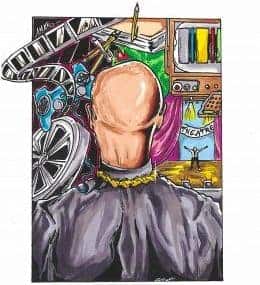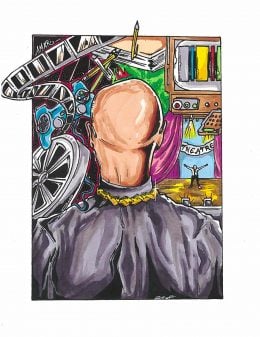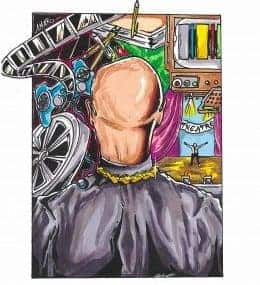Notes From The Field – Recap/ Review (with Spoilers)
Over the course of 18 characters, Anna Deavere Smith doesn’t just present a masterclass in acting but also understanding the various aspects of the school to prison pipeline.
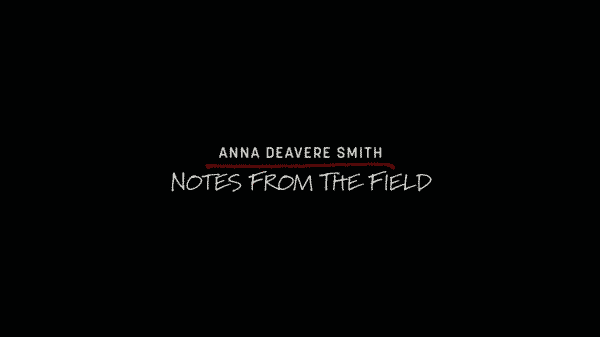
Spoiler Alert: This summary and review contains spoilers.
Additionally, some images and text may include affiliate links, meaning we may earn a commission or receive products if you make a purchase.
Over the course of 18 characters, Anna Deavere Smith doesn’t just present a masterclass in acting but also understanding the various aspects of the school to prison pipeline.
| Director(s) | Kristi Zea |
| Screenplay By | Anna Deavere Smith |
| Date Released | 2/24/2018 |
| Genre(s) | Drama, Stage Play |
| Noted Actors | |
| Various | Anna Deavere Smith |
Summary
Using approximately 18 characters, ranging from those that society would consider leaders and professionals to common people, even criminals, Smith illuminates each person’s point of view. When speaking as Sherrilyn Hill, President, and Director of the NAACP – Counsel, she is poised, talks policy, and almost reeks of the well-intentioned, upper crust, Black folk who do care and look out for the disenfranchised but seem foreign to those who need her the most. Then as Stephanie Williams, an emotional support teacher in Philly, she represents the people in schools who come into work ready and are thrown to the wolves. Sometimes, like in her case, eventually becoming leaders of the pack, but there is also Tony Eady. Those who don’t necessarily believe tight hugs and babying fix the issue but are part of it. Kids don’t respect authority so authority reminds them they are not as empowered as they think they are.
It is all a very interesting back and forth in which you aren’t given this idea Smith is trying to play devil’s advocate in the process. Each one has a point of view, an understanding of the problem based on their daily lives, and rather than be devil’s advocate, Smith is trying to help you understand these people. Not give you some media painting of them with a certain spin, but these people, as they are, if they were given the opportunity to speak in a safe space. One in which, one mishap wouldn’t lead to them being doxed on social media, labeled a thug by news broadcasters or having their words debated by pundits who barely understand what they have gone through.
What Smith tries to give us is people as they are, made more eloquent.
Other Noteworthy Facts & Moments
- There were 250 interviews done and based on her BUILD series interview, this is perhaps the least amount Smith has done for crafting a stage play.
Highlights
Gives Enough Time To Know Who She Represents, Even When Going Back And Forth
It’s the little things that count and having enough time, whether taking notes or not, to read who the person is, where they are from, and what their situation is, is rather important. Especially since the transitions, like when it was going between Niya Kenny and Amanda Ripley, were back and forth about the same situation. But alongside that, considering that Smith does not introduce these people, she just walks out on stage, changes one to two pieces of her outfit, and that’s it, this extended amount of time introducing people helps immensely.
Varied Stories, Of Which Most Were Well Known
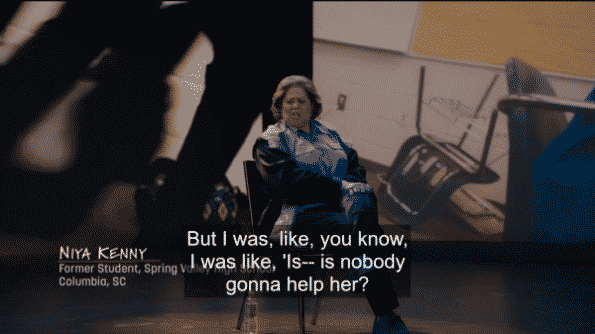 Okay, maybe not all of these are well known, but I feel if you have paid any attention to the news for the last 5+ years, you’ll know the Freddie Gray situation and be aware of the incident where a young woman named Shakara was manhandled, over a cell phone, and wrangled out of her desk. This is alongside a girl, skinny and in a bikini, in Texas, being treated like a threat and, of course, the massacre at Mother Emanuel AME Church. All of which you are reminded of by video and given what happened ultimately.
Okay, maybe not all of these are well known, but I feel if you have paid any attention to the news for the last 5+ years, you’ll know the Freddie Gray situation and be aware of the incident where a young woman named Shakara was manhandled, over a cell phone, and wrangled out of her desk. This is alongside a girl, skinny and in a bikini, in Texas, being treated like a threat and, of course, the massacre at Mother Emanuel AME Church. All of which you are reminded of by video and given what happened ultimately.
Yet, while these tentpole topics are of interest, especially since they present viewpoints of those who witnessed the situations, you can’t discount the lesser known stories or people. Such as Taos Proctor’s story. A Native American male who went from school to school, with a reputation of a bad attitude and violence left from which he came. Yet, he somehow turnt it around it seems.
But also, Smith presents another side. Not just that of witnesses or those who experienced the issue the system creates, but also the people trying to fix the problem – in their own way. Like the aforementioned Tony Eady, is his method the absolute best way of teaching kids to respect authority? No. However, neither is Stephanie Williams’ either. Yet, you can’t ignore how their contribution helps many and perhaps does nothing for some. For their parts in the larger conversation is just as important as the microcosms which often become the big issue.
On The Fence
It’s Hard To Not Want Some Background On Smith’s Actual Conversation With These People
 All of these characters are based on interviews Smith did. Their mannerisms, what they say, and probably how they looked at her. Yet, it is hard to not question how she was able to get them comfortable enough to say certain things. How she reacted to hearing some things and dealing with how she completely removes herself from the conversation. For you know these people didn’t just prep a monologue and had her be a sounding board.
All of these characters are based on interviews Smith did. Their mannerisms, what they say, and probably how they looked at her. Yet, it is hard to not question how she was able to get them comfortable enough to say certain things. How she reacted to hearing some things and dealing with how she completely removes herself from the conversation. For you know these people didn’t just prep a monologue and had her be a sounding board.
And I think when it came to transitioning from one person to another, even the big topics like “Trauma” or “Prison or Death,” her allowing her voice to be inserted into the conversation wouldn’t have been terrible. Maybe a little confusing, to a certain degree, but thinking about how some, like John Leguizamo, handle conversations between multiple characters on stage, it isn’t like an example wasn’t there.
Yet, Smith isn’t trying to present a comedy. She, again, is presenting real people talking about a significant issue in society. One which, of course, she has an opinion on, but what she is trying to illuminate is other people and their perspective. For as much as Ms. Hill has a very renowned platform, her name isn’t common knowledge. As much as we all probably knew someone like Ms. Williams or Mr. Eady, their opinions and person only exist in the school they work at. They don’t get this kind of exposure and like most good journalist or interviewers, Smith perhaps only wanted to allow enough of herself into the discussion to get what she needed from her subject. So that, ultimately, she could be as we see her on stage – simply a medium.
Overall: Positive (Watch This) – Recommended
I’m still kicking myself for not seeing this while it was playing in New York. Especially considering how Smith, in the BUILD series interview, discussed how she had the audience take part and the show wasn’t made into a series of monologue. Now, granted, it seems like those conversations were made to give her time to change, but you can’t deny what she does here doesn’t inspire curiosity. To the point, you have to want access to her past shows in which she does this.
Leading to the positive label and recommendation. Personally, I figured I’d have no reason to renew my HBO subscription until Westworld or Insecure came back with a new season. However, this popping up justifies the little over $15 charge it did. For while it would have been preferable to see live, just having access to the experience is what make me wish more plays were filmed and released to the masses like this.
Follow Wherever I Look on Twitter or Like us on Facebook.
Stream By Clicking The Link or Image Below
Gives Enough Time To Know Who She Represents, Even When Going Back And Forth - 91%
Varied Stories, Of Which Most Were Well Known - 92%
It’s Hard To Not Want Some Background On Smith’s Actual Conversation With These People - 78%
87%
while it would have been preferable to see live, just having access to the experience is what make me wish more plays were filmed and released to the masses like this.
